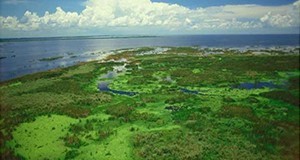Abstract
During the summer, many of Florida's nutrient-enriched lakes and reservoirs experience proliferations of cyanobacteria commonly called “blooms.” Cyanobacteria are natural in Florida lakes and reservoirs, but when they grow to high levels and bloom, they become a big problem. They look awful, smell bad, and can poison fish and other animals in the water. To help resource managers considering costly remediation projects or evaluating the effectiveness of nutrient reduction strategies to manage the problem, this 7-page fact sheet presents the results from 15 years of studies observing three large, nutrient-rich lakes in Florida (Lake Harris, Lake George, and Lake Okeechobee) to study the relationship between rainfall and cyanobacteria blooms and learn causes of year-to-year bloom variability. Written by Karl E. Havens, Mark V. Hoyer, and Edward J. Phlips, and published by the Florida Sea Grant College Program, July 2016.
References
Abtew, W., and P. Trimble. 2010. "El Niño-Southern Oscillation link to south Florida hydrology and water management applications." Water Resources Management 24: 4255-4271. https://doi.org/10.1007/s11269-010-9656-2
Aldridge, F. J., E. J. Phlips, and C. L. Schelske. 1995. "The use of nutrient enrichment bioassays to test for spatial and temporal distribution of limiting factors affecting phytoplankton dynamics of Lake Okeechobee, Florida." Archiv für Hydrobiologie, Advances in Limnology 45: 177-190.
Bachmann, R. W., D. L. Bigham, M. V. Hoyer, and D. E. Canfield, Jr. 2012. "Factors determining the distributions of total phosphorus, total nitrogen and chlorophyll a in Florida lakes." Lake and Reservoir Management 28: 10-26. https://doi.org/10.1080/07438141.2011.646458
Havens, K. E., R. S. Fulton III, J. R. Beaver, E. E. Samples, and J. Collee. 2016a. "Effects of climate variability on cladoceran zooplankton and cyanobacteria in a shallow subtropical lake." Journal of Plankton Research, DOI 10.1093/plankt/fwb009. https://doi.org/10.1093/plankt/fbw009
Havens, K. E., M. C. Harwell, M. A. Brady, B. Sharfstein, T. L. East, A. J. Rodusky, D. Anson, and R. P. Maki. 2002. "Large-scale mapping and predictive modeling of submerged aquatic vegetation in a shallow eutrophic lake." The Scientific World Journal 2: 949-965. https://doi.org/10.1100/tsw.2002.194
Havens, K. E., H. Paerl, E. J. Phlips, M. Zhu, J. R. Beaver, and A. Srifa. 2016b. "Extreme weather events and climate variability provide a lens into how shallow lakes may respond to climate change." Water 8:229 (DOI:10.3390/w8060229). https://doi.org/10.3390/w8060229
Havens, K. E., E. J. Phlips, M. F. Cichra, and B. L. Li. 1998. "Light availability as a possible regulator of cyanobacteria species composition in a shallow subtropical lake." Hydrobiologia 39: 547-556. https://doi.org/10.1046/j.1365-2427.1998.00308.x
Hoyer, M. V., C. A. Horsbaugh, D. E. Canfield, and R. W. Bachmann. 2005. "Lake level and trophic state variables among a population of shallow Florida lakes and within individual lakes." Canadian Journal of Fisheries and Aquatic Sciences 62: 2760-2769. https://doi.org/10.1139/f05-177
Hwang, S. J., K. E. Havens, and A. D. Steinman. 1998. "Phosphorus kinetics of planktonic and benthic assemblages in a shallow subtropical lake." Freshwater Biology 40: 729-745. https://doi.org/10.1046/j.1365-2427.1998.d01-660.x
James, R. T., K. O'Dell, and V. H. Smith. 1994. "Water quality trends in Lake Tohopekaliga, Florida, USA: responses to watershed management." Journal of the American Water Resources Association 30: 531-546. https://doi.org/10.1111/j.1752-1688.1994.tb03311.x
Knowlton, M. F., and J. R. Jones. 2006. "Temporal variation and assessment of trophic state indicators in Missouri reservoirs: implication for lake monitoring and management." Lake and Reservoir Management 23: 261-271. https://doi.org/10.1080/07438140609353904
Obeysekera, J., J. Barnes, and M. Nungesser. 2015. "Climate sensitivity runs and regional hydrologic modeling for predicting the response of the greater Florida Everglades ecosystem to climate changes." Environmental Management 55: 749-762. (DOI 10.1007/s00267-014-0315-x.) https://doi.org/10.1007/s00267-014-0315-x
Phlips, E. J., F. J. Aldridge, P. Hansen, P. V. Zimba, J. Ihnat, M. Conroy, and P. Ritter. 1993. "Spatial and temporal variability of trophic state parameters in a shallow subtropical lake (Lake Okeechobee, Florida, USA)." Archives Hydrobiologia 128:437-458.
Phlips, E. J., F. J. Aldridge, C. L. Schelske, and T. L. Crisman. 1995. "Relationship between light availability, chlorophyll a and tripton in a large shallow sub-tropical lake." Limnology and Oceanography 40:416-421. https://doi.org/10.4319/lo.1995.40.2.0416
Scheffer, M., S. H. Hosper, M. L. Meijer, B. Moss, and E. Jeppesen. 1993. "Alternative equilibria in shallow lakes." Trends Ecol. Evol. 8: 275-279. https://doi.org/10.1016/0169-5347(93)90254-M
Srifa, A., E. J. Phlips, M. F. Cichra, and J. C. Hendrickson. 2016. "Phytoplankton dynamics in a sub-tropical lake dominated by cyanobacteria: Cyanobacteria 'like it hot and sometimes dry." Aquatic Ecology 50:163-174 (http://dx.DOI.org/10.1007/s10452-016-9565-4). https://doi.org/10.1007/s10452-016-9565-4

